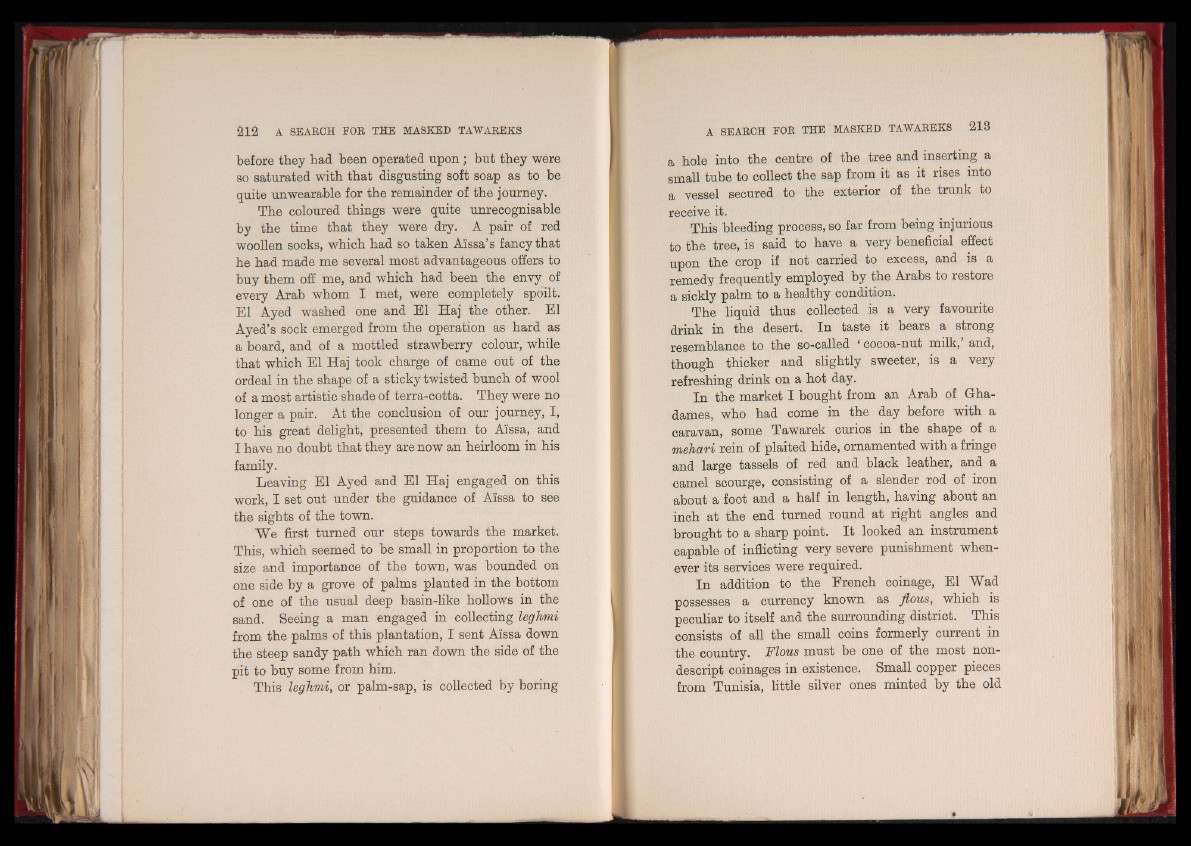
before tbey had been operated upon ; but they were
so saturated with that disgusting soft soap as to be
quite unwearable for the remainder of the journey.
The coloured things were quite unrecognisable
by the time that they were dry. A pair of red
woollen socks, which had so taken Aissa’s fancy that
he had made me several most advantageous offers to
buy them off me, and which had been the envy of
every Arab whom I met, were completely spoilt.
El Ayed washed one and El Haj the other. El
Ayed’s sock emerged from the operation as hard as
a board, and of a mottled strawberry colour, while
that which El Haj took charge of came out of the
ordeal in the shape of a sticky twisted bunch of wool
of a most artistic shade of terra-cotta. They were no
longer a pair. At the conclusion of our journey, I,
to his great delight, presented them to Aissa, and
I have no doubt that they are now an heirloom in his
family.
Leaving El Ayed and El Haj engaged on this
work, I set out under the guidance of Aissa to see
the sights of the town.
We first turned our steps towards the market.
This, which seemed to be small in proportion to the
size and importance of the town, was bounded on
one side by a grove of palms planted in the bottom
of one of the usual deep basin-like hollows in the
sand. Seeing a man engaged in collecting leghmi
from the palms of this plantation, I sent Aissa down
the steep sandy path which ran down the side of the
pit to buy some from him.
This leghmi, or palm-sap, is collected by boring
a hole into the centre of the tree and inserting a
small tube to collect the sap from it as it rises into
a vessel secured to the exterior of the trunk to
receive it.
This bleeding process, so far from being injurious
to the tree, is said to have a very beneficial effect
upon the crop if not carried to excess, and is a
remedy frequently employed by the Arabs to restore
a sickly palm to a healthy condition.
The liquid thus collected is a very favourite
drink in the desert. In taste it bears a strong
resemblance to the so-called (cocoa-nut milk, and,
though thicker and slightly sweeter, is a very
refreshing drink on a hot day.
In the market I bought from an Arab of Gha-
dames, who had come in the day before with a
caravan, some Tawarek curios in the shape of a
mehari rein of plaited hide, ornamented with a fringe
and large tassels of red and black leather, and a
camel scourge, consisting of a slender rod of iron
about a foot and a half in length, having about an
inch at the end turned round at right angles and
brought to a sharp point. It looked an instrument
capable of inflicting very severe punishment whenever
its services were required.
In addition to the Erench coinage, El Wad
possesses a currency known as flous, which is
peculiar to itself and the surrounding district. This
consists of all the small coins formerly current in
the country. Flous must be one of the most nondescript
coinages in existence. Small copper pieces
from Tunisia, little silver ones minted by the old